Analysis of Evidence: Team-Based Management of Hypertension
VerifiedAdded on 2022/08/25
|5
|1170
|19
Report
AI Summary
This report critically examines the credibility of evidence related to hypertension management, focusing on the effectiveness of team-based approaches and the use of ambulatory blood pressure monitoring (ABPM). It highlights the global prevalence of hypertension and the potential of team-based interventions to reduce associated risks, such as cardiovascular diseases and stroke, by improving diagnosis, medication management, patient education, and overall care quality. The report also explores the benefits of ABPM in accurately diagnosing hypertension, including white-coat hypertension, and its role in predicting cardiovascular outcomes. While acknowledging limitations such as data specificity and the need for long-term intervention studies, the analysis emphasizes the importance of evidence-based practice in improving patient outcomes and reducing healthcare costs in the context of hypertension management.
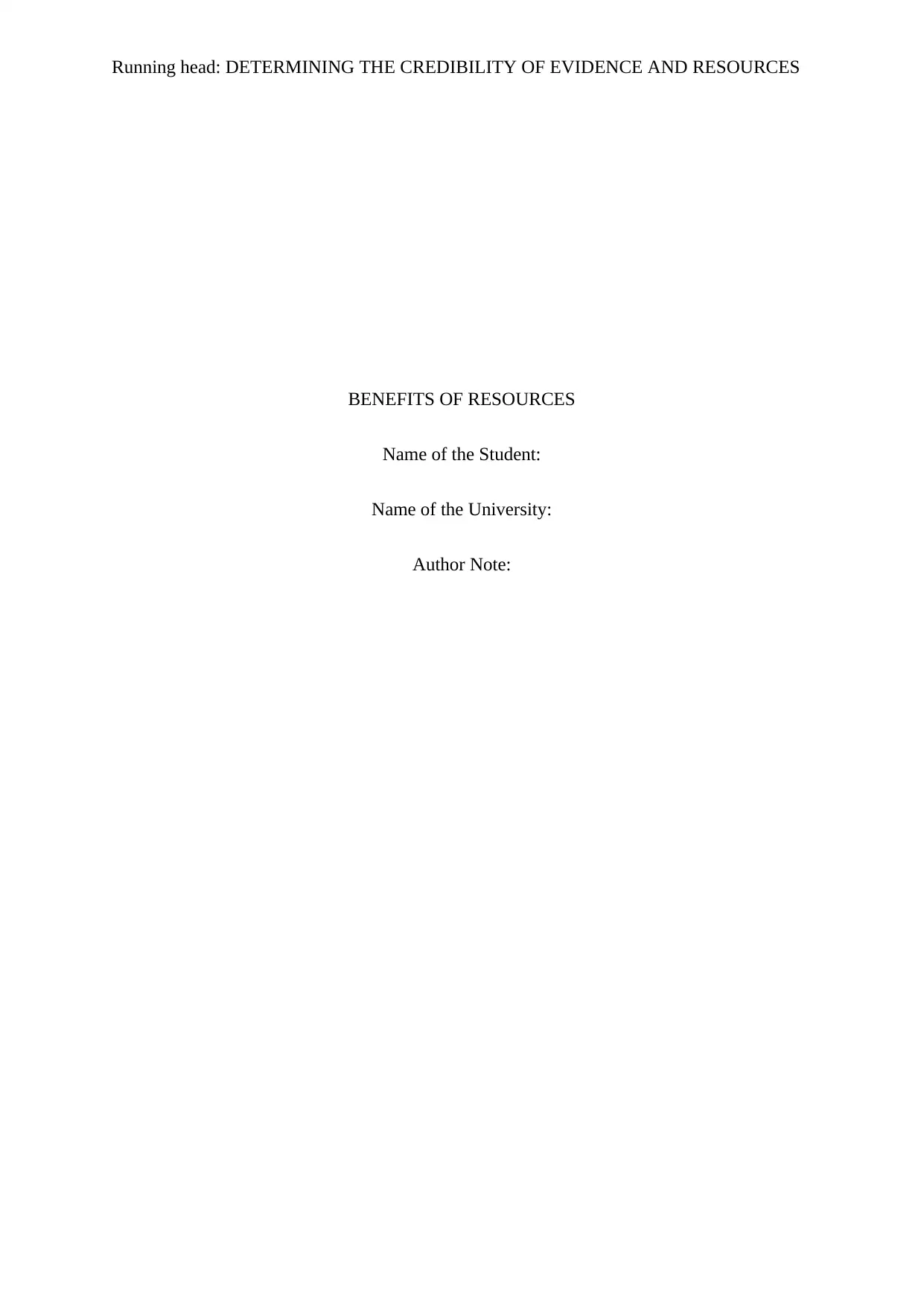
Running head: DETERMINING THE CREDIBILITY OF EVIDENCE AND RESOURCES
BENEFITS OF RESOURCES
Name of the Student:
Name of the University:
Author Note:
BENEFITS OF RESOURCES
Name of the Student:
Name of the University:
Author Note:
Paraphrase This Document
Need a fresh take? Get an instant paraphrase of this document with our AI Paraphraser
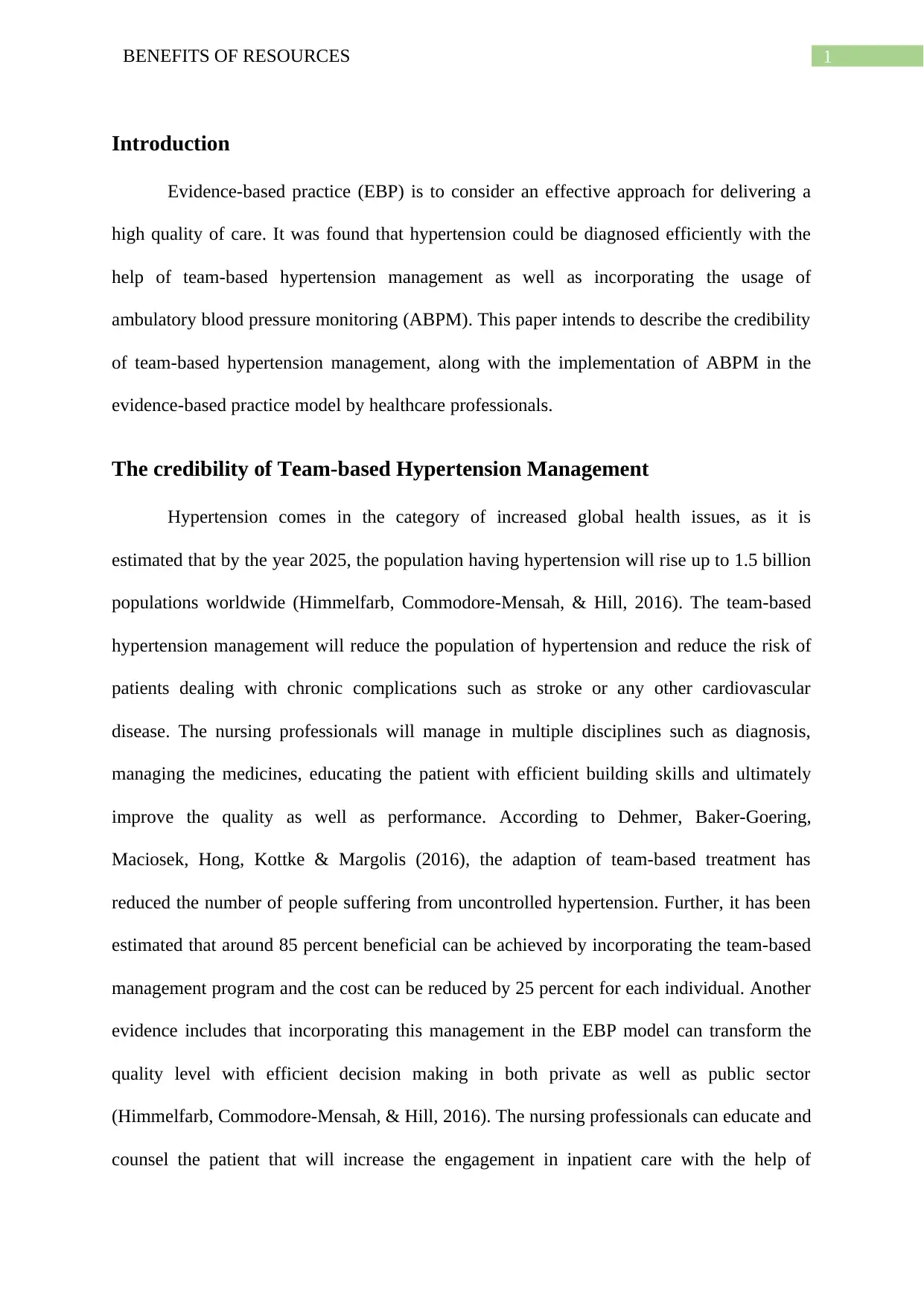
1BENEFITS OF RESOURCES
Introduction
Evidence-based practice (EBP) is to consider an effective approach for delivering a
high quality of care. It was found that hypertension could be diagnosed efficiently with the
help of team-based hypertension management as well as incorporating the usage of
ambulatory blood pressure monitoring (ABPM). This paper intends to describe the credibility
of team-based hypertension management, along with the implementation of ABPM in the
evidence-based practice model by healthcare professionals.
The credibility of Team-based Hypertension Management
Hypertension comes in the category of increased global health issues, as it is
estimated that by the year 2025, the population having hypertension will rise up to 1.5 billion
populations worldwide (Himmelfarb, Commodore-Mensah, & Hill, 2016). The team-based
hypertension management will reduce the population of hypertension and reduce the risk of
patients dealing with chronic complications such as stroke or any other cardiovascular
disease. The nursing professionals will manage in multiple disciplines such as diagnosis,
managing the medicines, educating the patient with efficient building skills and ultimately
improve the quality as well as performance. According to Dehmer, Baker-Goering,
Maciosek, Hong, Kottke & Margolis (2016), the adaption of team-based treatment has
reduced the number of people suffering from uncontrolled hypertension. Further, it has been
estimated that around 85 percent beneficial can be achieved by incorporating the team-based
management program and the cost can be reduced by 25 percent for each individual. Another
evidence includes that incorporating this management in the EBP model can transform the
quality level with efficient decision making in both private as well as public sector
(Himmelfarb, Commodore-Mensah, & Hill, 2016). The nursing professionals can educate and
counsel the patient that will increase the engagement in inpatient care with the help of
Introduction
Evidence-based practice (EBP) is to consider an effective approach for delivering a
high quality of care. It was found that hypertension could be diagnosed efficiently with the
help of team-based hypertension management as well as incorporating the usage of
ambulatory blood pressure monitoring (ABPM). This paper intends to describe the credibility
of team-based hypertension management, along with the implementation of ABPM in the
evidence-based practice model by healthcare professionals.
The credibility of Team-based Hypertension Management
Hypertension comes in the category of increased global health issues, as it is
estimated that by the year 2025, the population having hypertension will rise up to 1.5 billion
populations worldwide (Himmelfarb, Commodore-Mensah, & Hill, 2016). The team-based
hypertension management will reduce the population of hypertension and reduce the risk of
patients dealing with chronic complications such as stroke or any other cardiovascular
disease. The nursing professionals will manage in multiple disciplines such as diagnosis,
managing the medicines, educating the patient with efficient building skills and ultimately
improve the quality as well as performance. According to Dehmer, Baker-Goering,
Maciosek, Hong, Kottke & Margolis (2016), the adaption of team-based treatment has
reduced the number of people suffering from uncontrolled hypertension. Further, it has been
estimated that around 85 percent beneficial can be achieved by incorporating the team-based
management program and the cost can be reduced by 25 percent for each individual. Another
evidence includes that incorporating this management in the EBP model can transform the
quality level with efficient decision making in both private as well as public sector
(Himmelfarb, Commodore-Mensah, & Hill, 2016). The nursing professionals can educate and
counsel the patient that will increase the engagement in inpatient care with the help of
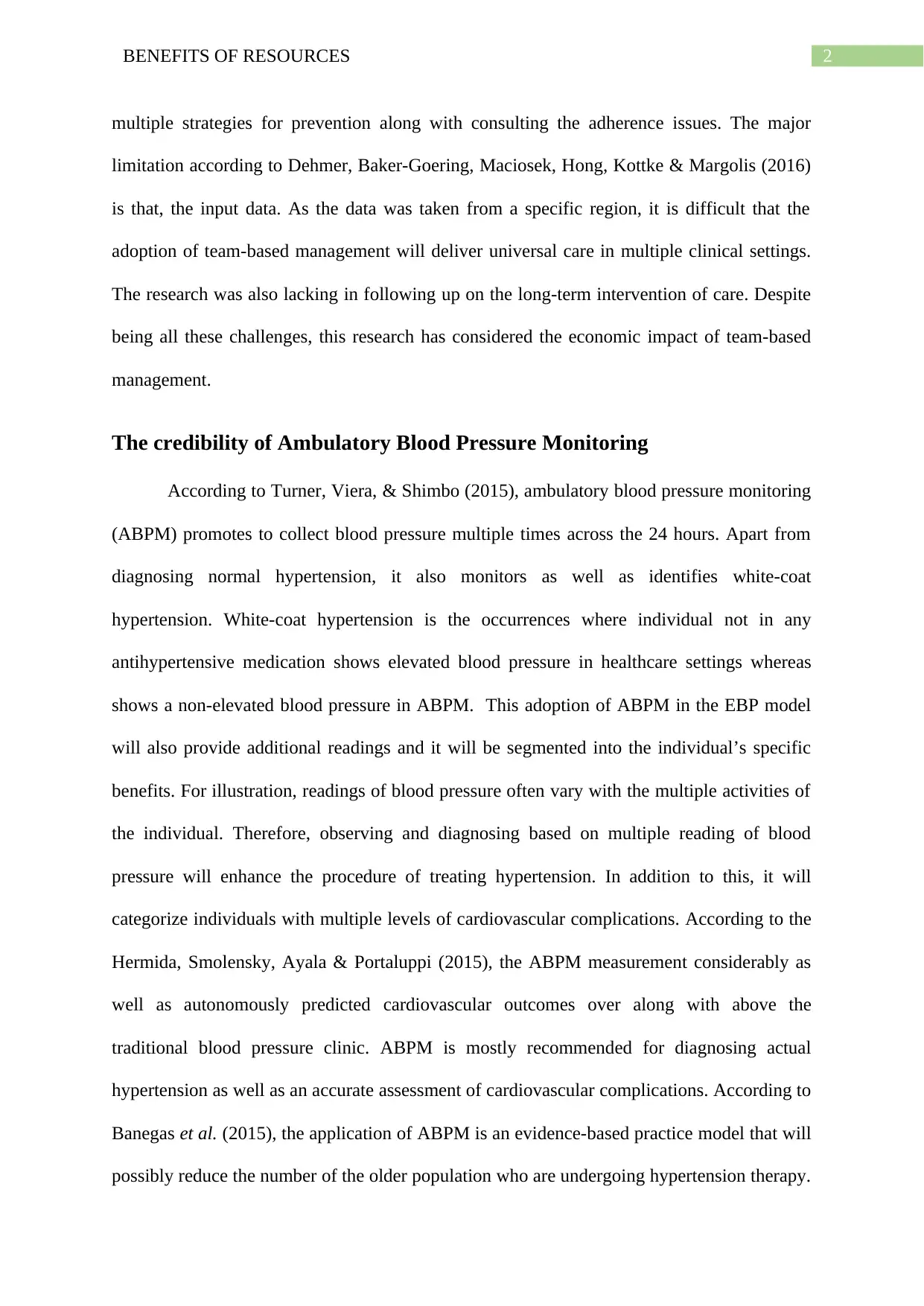
2BENEFITS OF RESOURCES
multiple strategies for prevention along with consulting the adherence issues. The major
limitation according to Dehmer, Baker-Goering, Maciosek, Hong, Kottke & Margolis (2016)
is that, the input data. As the data was taken from a specific region, it is difficult that the
adoption of team-based management will deliver universal care in multiple clinical settings.
The research was also lacking in following up on the long-term intervention of care. Despite
being all these challenges, this research has considered the economic impact of team-based
management.
The credibility of Ambulatory Blood Pressure Monitoring
According to Turner, Viera, & Shimbo (2015), ambulatory blood pressure monitoring
(ABPM) promotes to collect blood pressure multiple times across the 24 hours. Apart from
diagnosing normal hypertension, it also monitors as well as identifies white-coat
hypertension. White-coat hypertension is the occurrences where individual not in any
antihypertensive medication shows elevated blood pressure in healthcare settings whereas
shows a non-elevated blood pressure in ABPM. This adoption of ABPM in the EBP model
will also provide additional readings and it will be segmented into the individual’s specific
benefits. For illustration, readings of blood pressure often vary with the multiple activities of
the individual. Therefore, observing and diagnosing based on multiple reading of blood
pressure will enhance the procedure of treating hypertension. In addition to this, it will
categorize individuals with multiple levels of cardiovascular complications. According to the
Hermida, Smolensky, Ayala & Portaluppi (2015), the ABPM measurement considerably as
well as autonomously predicted cardiovascular outcomes over along with above the
traditional blood pressure clinic. ABPM is mostly recommended for diagnosing actual
hypertension as well as an accurate assessment of cardiovascular complications. According to
Banegas et al. (2015), the application of ABPM is an evidence-based practice model that will
possibly reduce the number of the older population who are undergoing hypertension therapy.
multiple strategies for prevention along with consulting the adherence issues. The major
limitation according to Dehmer, Baker-Goering, Maciosek, Hong, Kottke & Margolis (2016)
is that, the input data. As the data was taken from a specific region, it is difficult that the
adoption of team-based management will deliver universal care in multiple clinical settings.
The research was also lacking in following up on the long-term intervention of care. Despite
being all these challenges, this research has considered the economic impact of team-based
management.
The credibility of Ambulatory Blood Pressure Monitoring
According to Turner, Viera, & Shimbo (2015), ambulatory blood pressure monitoring
(ABPM) promotes to collect blood pressure multiple times across the 24 hours. Apart from
diagnosing normal hypertension, it also monitors as well as identifies white-coat
hypertension. White-coat hypertension is the occurrences where individual not in any
antihypertensive medication shows elevated blood pressure in healthcare settings whereas
shows a non-elevated blood pressure in ABPM. This adoption of ABPM in the EBP model
will also provide additional readings and it will be segmented into the individual’s specific
benefits. For illustration, readings of blood pressure often vary with the multiple activities of
the individual. Therefore, observing and diagnosing based on multiple reading of blood
pressure will enhance the procedure of treating hypertension. In addition to this, it will
categorize individuals with multiple levels of cardiovascular complications. According to the
Hermida, Smolensky, Ayala & Portaluppi (2015), the ABPM measurement considerably as
well as autonomously predicted cardiovascular outcomes over along with above the
traditional blood pressure clinic. ABPM is mostly recommended for diagnosing actual
hypertension as well as an accurate assessment of cardiovascular complications. According to
Banegas et al. (2015), the application of ABPM is an evidence-based practice model that will
possibly reduce the number of the older population who are undergoing hypertension therapy.
⊘ This is a preview!⊘
Do you want full access?
Subscribe today to unlock all pages.

Trusted by 1+ million students worldwide
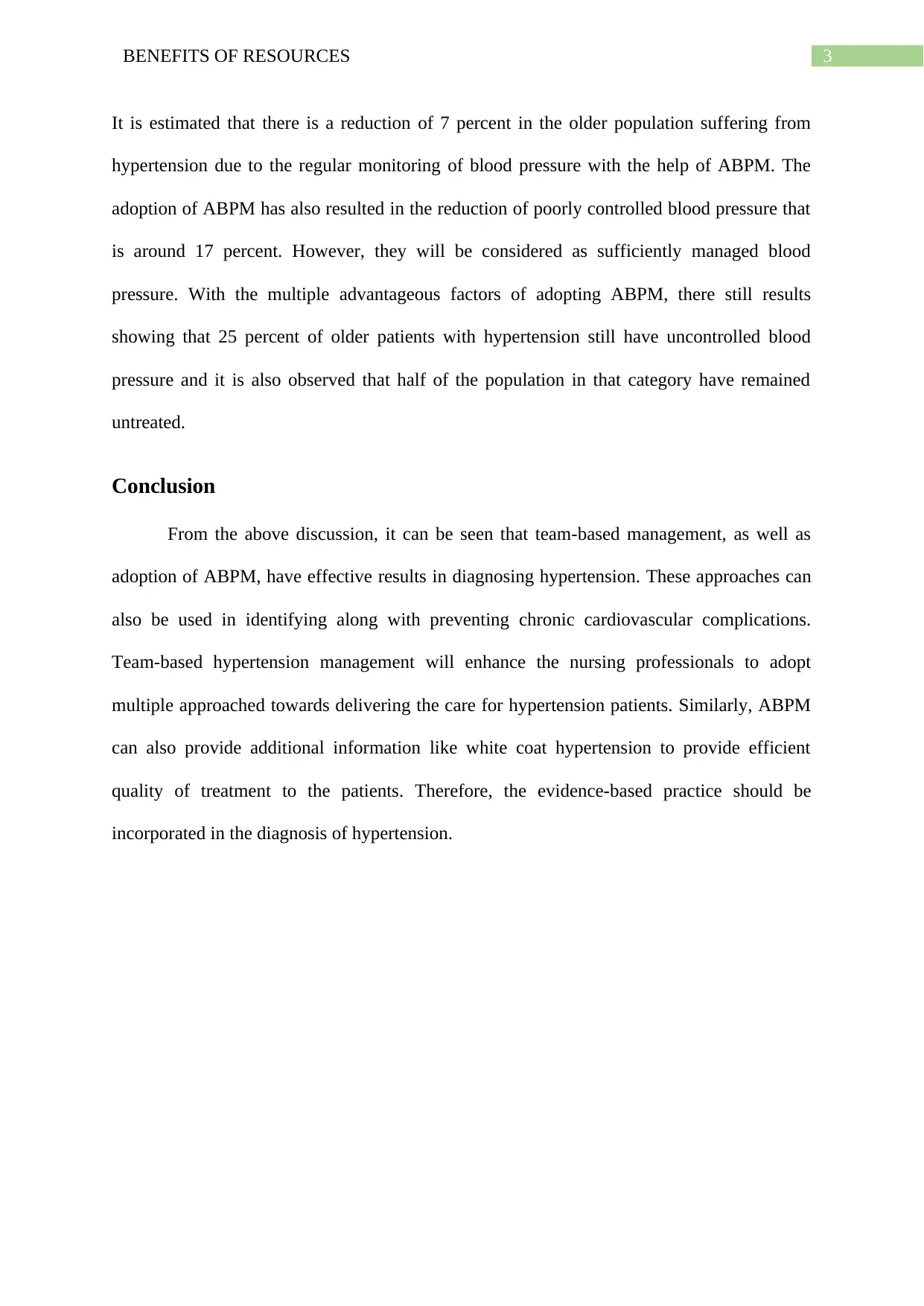
3BENEFITS OF RESOURCES
It is estimated that there is a reduction of 7 percent in the older population suffering from
hypertension due to the regular monitoring of blood pressure with the help of ABPM. The
adoption of ABPM has also resulted in the reduction of poorly controlled blood pressure that
is around 17 percent. However, they will be considered as sufficiently managed blood
pressure. With the multiple advantageous factors of adopting ABPM, there still results
showing that 25 percent of older patients with hypertension still have uncontrolled blood
pressure and it is also observed that half of the population in that category have remained
untreated.
Conclusion
From the above discussion, it can be seen that team-based management, as well as
adoption of ABPM, have effective results in diagnosing hypertension. These approaches can
also be used in identifying along with preventing chronic cardiovascular complications.
Team-based hypertension management will enhance the nursing professionals to adopt
multiple approached towards delivering the care for hypertension patients. Similarly, ABPM
can also provide additional information like white coat hypertension to provide efficient
quality of treatment to the patients. Therefore, the evidence-based practice should be
incorporated in the diagnosis of hypertension.
It is estimated that there is a reduction of 7 percent in the older population suffering from
hypertension due to the regular monitoring of blood pressure with the help of ABPM. The
adoption of ABPM has also resulted in the reduction of poorly controlled blood pressure that
is around 17 percent. However, they will be considered as sufficiently managed blood
pressure. With the multiple advantageous factors of adopting ABPM, there still results
showing that 25 percent of older patients with hypertension still have uncontrolled blood
pressure and it is also observed that half of the population in that category have remained
untreated.
Conclusion
From the above discussion, it can be seen that team-based management, as well as
adoption of ABPM, have effective results in diagnosing hypertension. These approaches can
also be used in identifying along with preventing chronic cardiovascular complications.
Team-based hypertension management will enhance the nursing professionals to adopt
multiple approached towards delivering the care for hypertension patients. Similarly, ABPM
can also provide additional information like white coat hypertension to provide efficient
quality of treatment to the patients. Therefore, the evidence-based practice should be
incorporated in the diagnosis of hypertension.
Paraphrase This Document
Need a fresh take? Get an instant paraphrase of this document with our AI Paraphraser
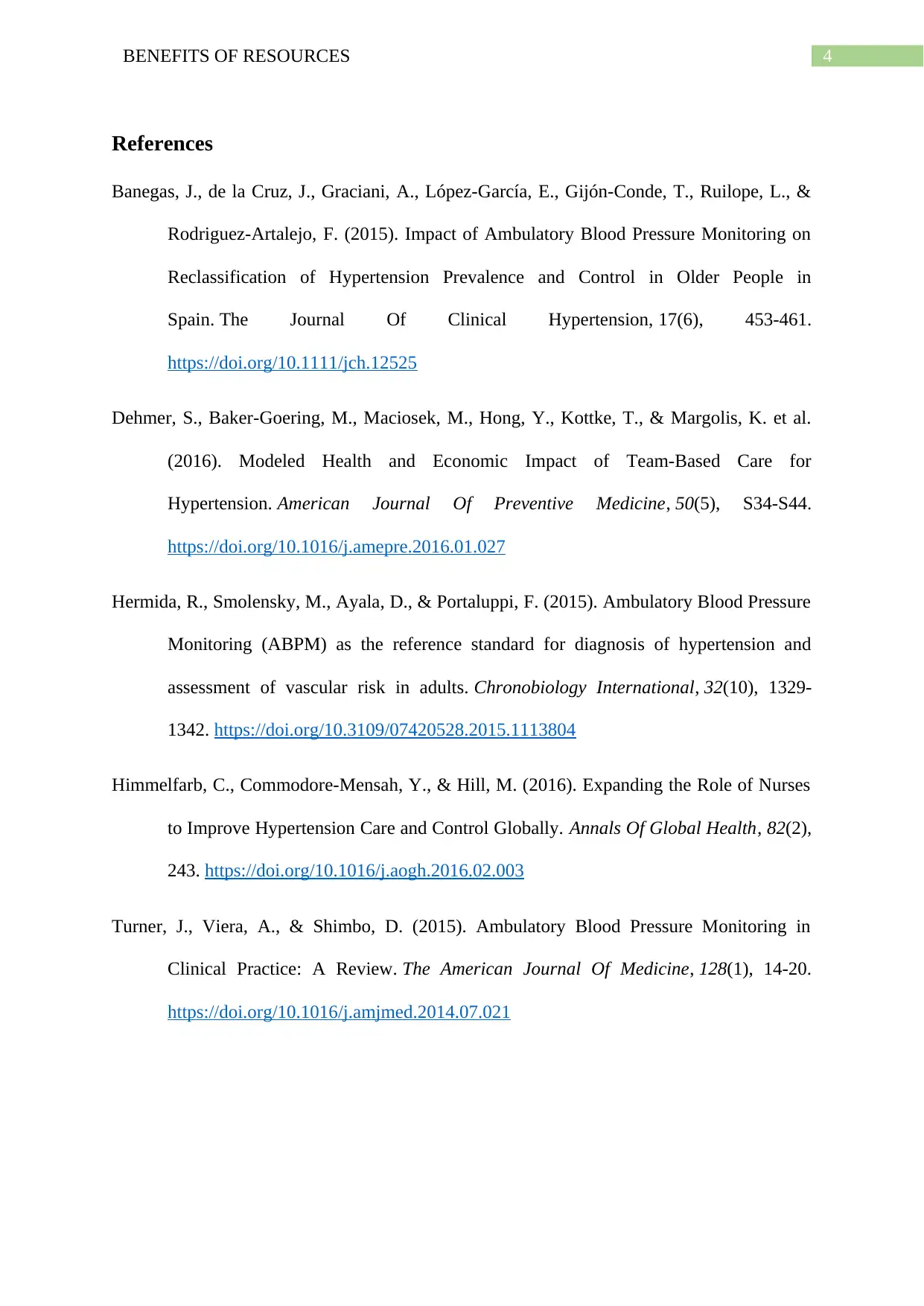
4BENEFITS OF RESOURCES
References
Banegas, J., de la Cruz, J., Graciani, A., López-García, E., Gijón-Conde, T., Ruilope, L., &
Rodriguez-Artalejo, F. (2015). Impact of Ambulatory Blood Pressure Monitoring on
Reclassification of Hypertension Prevalence and Control in Older People in
Spain. The Journal Of Clinical Hypertension, 17(6), 453-461.
https://doi.org/10.1111/jch.12525
Dehmer, S., Baker-Goering, M., Maciosek, M., Hong, Y., Kottke, T., & Margolis, K. et al.
(2016). Modeled Health and Economic Impact of Team-Based Care for
Hypertension. American Journal Of Preventive Medicine, 50(5), S34-S44.
https://doi.org/10.1016/j.amepre.2016.01.027
Hermida, R., Smolensky, M., Ayala, D., & Portaluppi, F. (2015). Ambulatory Blood Pressure
Monitoring (ABPM) as the reference standard for diagnosis of hypertension and
assessment of vascular risk in adults. Chronobiology International, 32(10), 1329-
1342. https://doi.org/10.3109/07420528.2015.1113804
Himmelfarb, C., Commodore-Mensah, Y., & Hill, M. (2016). Expanding the Role of Nurses
to Improve Hypertension Care and Control Globally. Annals Of Global Health, 82(2),
243. https://doi.org/10.1016/j.aogh.2016.02.003
Turner, J., Viera, A., & Shimbo, D. (2015). Ambulatory Blood Pressure Monitoring in
Clinical Practice: A Review. The American Journal Of Medicine, 128(1), 14-20.
https://doi.org/10.1016/j.amjmed.2014.07.021
References
Banegas, J., de la Cruz, J., Graciani, A., López-García, E., Gijón-Conde, T., Ruilope, L., &
Rodriguez-Artalejo, F. (2015). Impact of Ambulatory Blood Pressure Monitoring on
Reclassification of Hypertension Prevalence and Control in Older People in
Spain. The Journal Of Clinical Hypertension, 17(6), 453-461.
https://doi.org/10.1111/jch.12525
Dehmer, S., Baker-Goering, M., Maciosek, M., Hong, Y., Kottke, T., & Margolis, K. et al.
(2016). Modeled Health and Economic Impact of Team-Based Care for
Hypertension. American Journal Of Preventive Medicine, 50(5), S34-S44.
https://doi.org/10.1016/j.amepre.2016.01.027
Hermida, R., Smolensky, M., Ayala, D., & Portaluppi, F. (2015). Ambulatory Blood Pressure
Monitoring (ABPM) as the reference standard for diagnosis of hypertension and
assessment of vascular risk in adults. Chronobiology International, 32(10), 1329-
1342. https://doi.org/10.3109/07420528.2015.1113804
Himmelfarb, C., Commodore-Mensah, Y., & Hill, M. (2016). Expanding the Role of Nurses
to Improve Hypertension Care and Control Globally. Annals Of Global Health, 82(2),
243. https://doi.org/10.1016/j.aogh.2016.02.003
Turner, J., Viera, A., & Shimbo, D. (2015). Ambulatory Blood Pressure Monitoring in
Clinical Practice: A Review. The American Journal Of Medicine, 128(1), 14-20.
https://doi.org/10.1016/j.amjmed.2014.07.021
1 out of 5
Your All-in-One AI-Powered Toolkit for Academic Success.
+13062052269
info@desklib.com
Available 24*7 on WhatsApp / Email
![[object Object]](/_next/static/media/star-bottom.7253800d.svg)
Unlock your academic potential
Copyright © 2020–2025 A2Z Services. All Rights Reserved. Developed and managed by ZUCOL.


